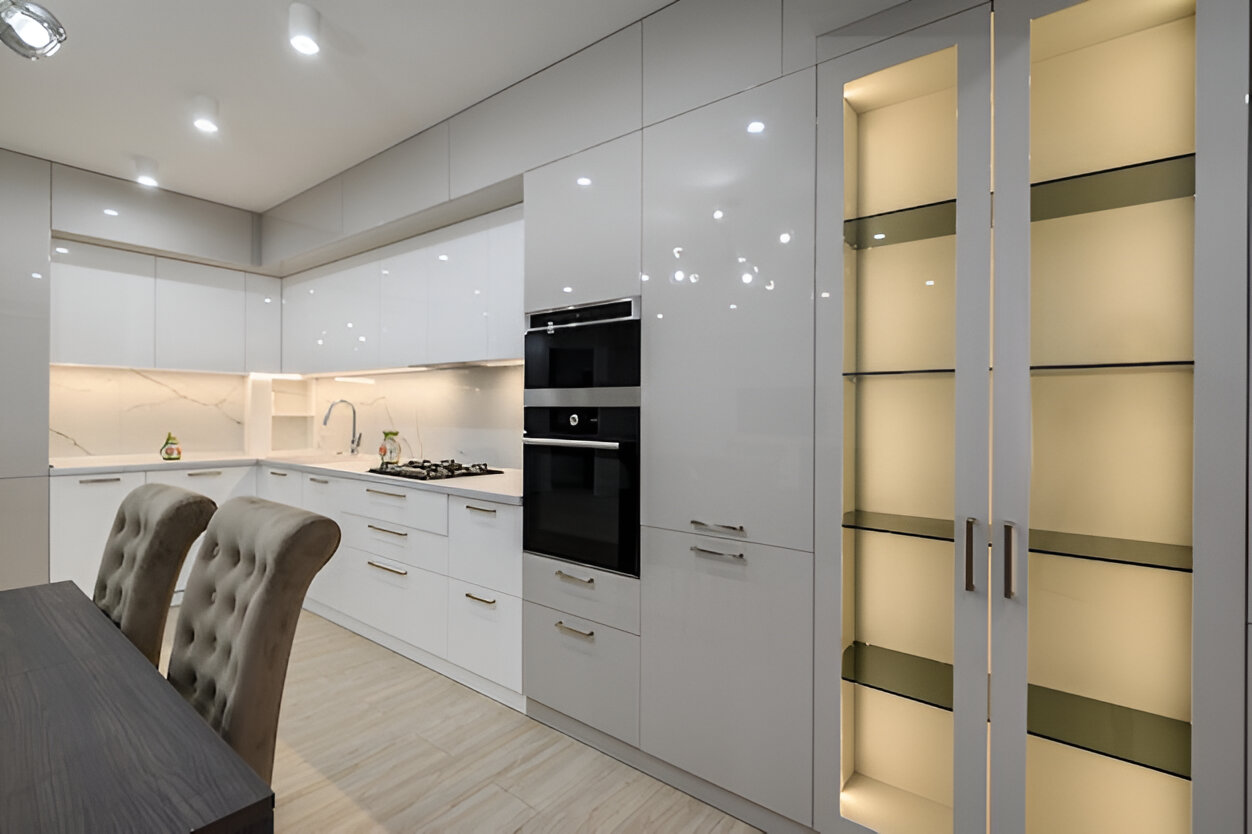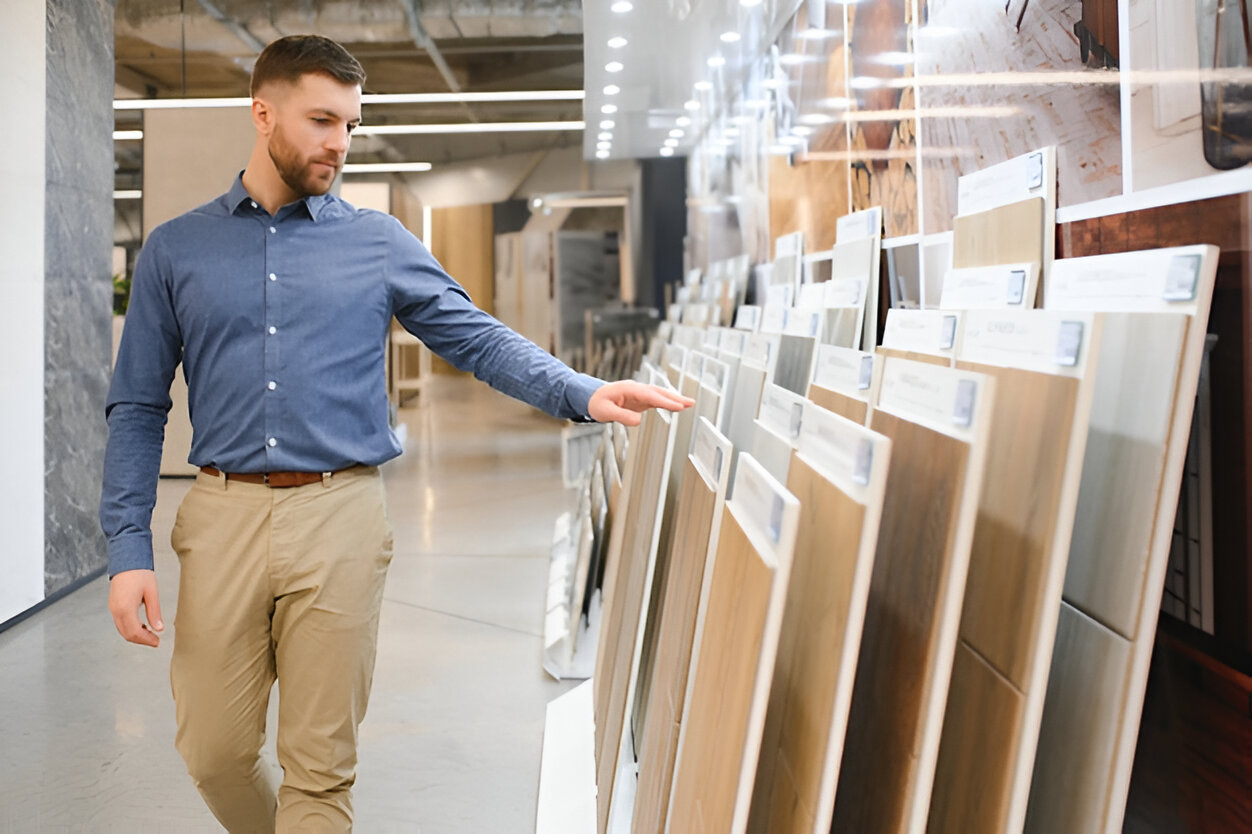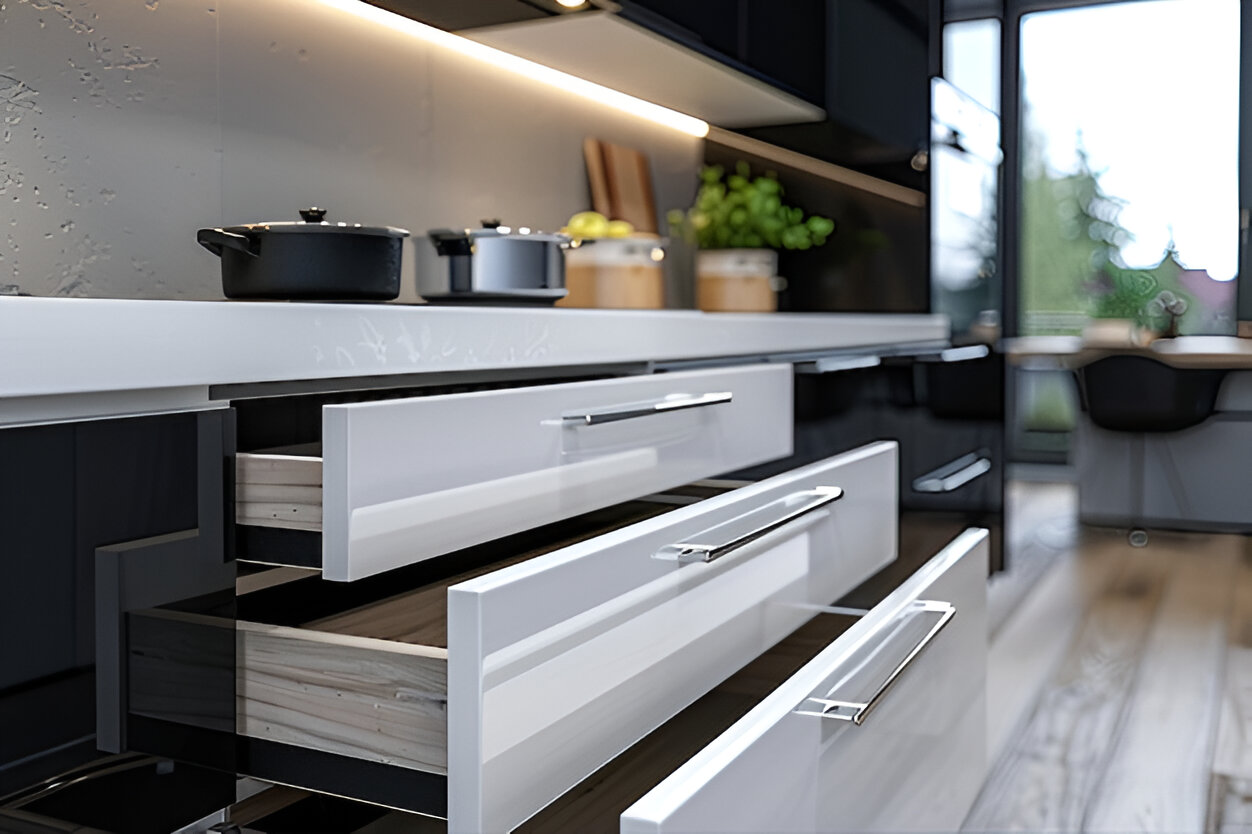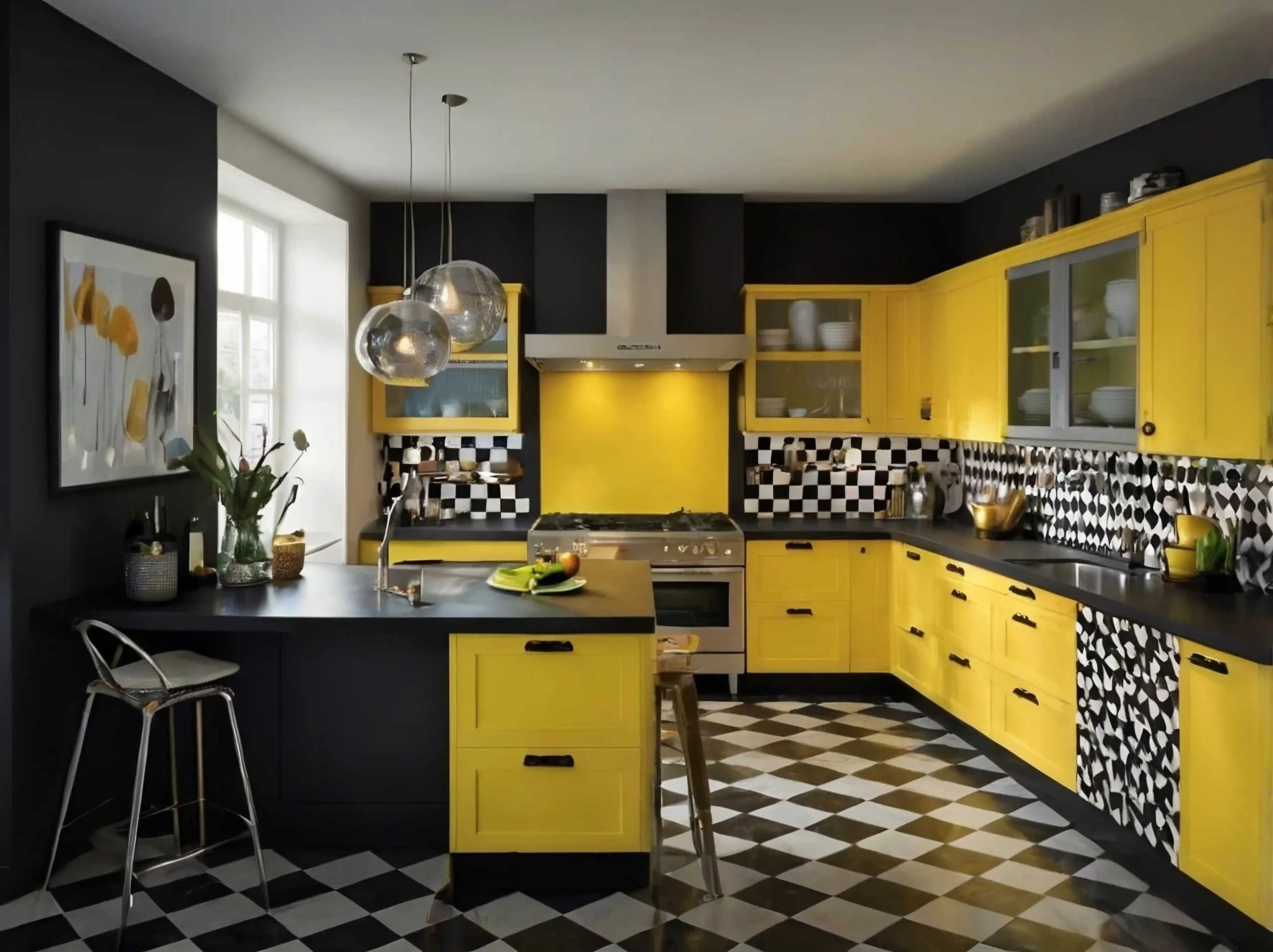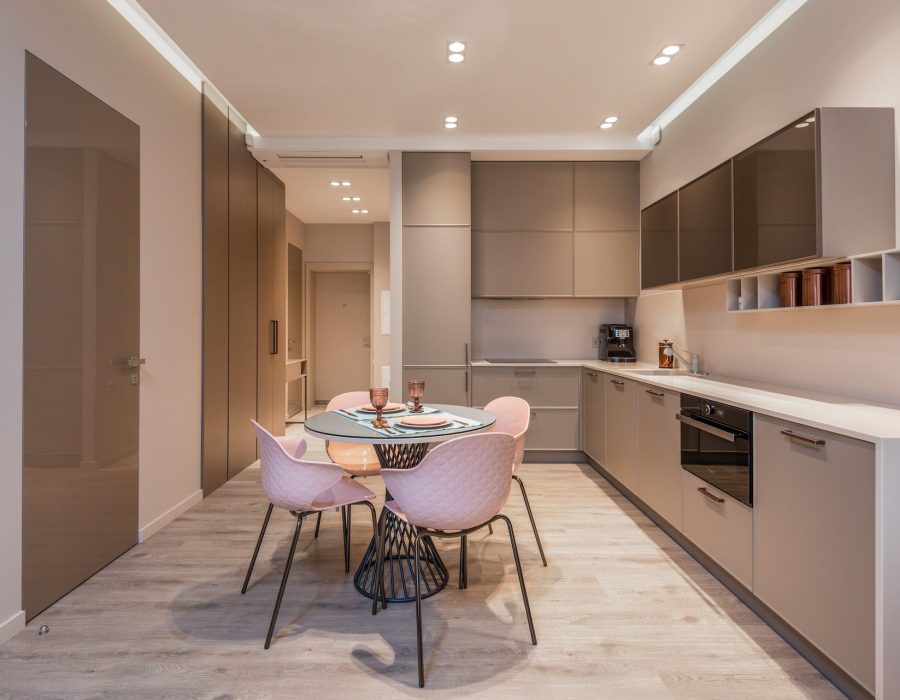The Flat Panel Cabinets vs. Raised Panel Cabinets debate has happened for years since both are popular choices. Both have their unique characteristics and visual appeal. Still, it’s essential to understand their differences to make an informed decision for your kitchen renovation or remodel project.
This article will explore the disparities between the flat panel and raised panel cabinets, delving into their styles, construction, benefits, and drawbacks. By the end, you’ll have a comprehensive understanding of these cabinet types, enabling you to choose the perfect option for your kitchen.
Flat Panel Cabinets
You can’t talk about raised panel vs. flat panel cabinets without knowing about the history of each. Flat panel cabinets originated in the mid-20th century as a response to the minimalist design trends of the time. Influenced by modernist and Scandinavian principles, these cabinets featured clean lines and a focus on functionality.
Flat, unadorned panels for doors and drawers created a sleek and contemporary look. Advancements in manufacturing techniques and materials have allowed for greater customization, ensuring the enduring popularity of flat panel cabinets in modern interior design.
Definition and Style
Flat panel cabinets, also known as slab cabinets, are a style of kitchen cabinets characterized by their sleek and minimalistic design. They feature a flat front panel with no raised or recessed detailing. Flat panel cabinets’ doors and drawer fronts are typically made from a single, flat piece of wood, laminate, or MDF (medium-density fiberboard).
This style of cabinets often emphasizes clean lines, straight edges, and a contemporary aesthetic. Flat panel cabinets are popular in modern and minimalist kitchen designs, creating a streamlined and uncluttered look. They offer a versatile canvas for various finishes, colors, and hardware options, allowing customization to suit different design preferences.
Construction and Design
Flat panel cabinets are constructed using a straightforward and efficient manufacturing process. The construction involves creating a frame from solid wood or engineered wood materials, such as plywood or MDF. This frame serves as the base structure for the cabinet doors and drawers. The flat front panels are attached to the frame, covering the openings and creating a seamless, uniform appearance. The panels can be made from various materials, including wood veneer, laminate, thermofoil, or glass.
The design of flat panel cabinets focuses on simplicity and clean lines, with the absence of raised or recessed detailing. The cabinet doors and drawer fronts are typically square or rectangular, with straight edges and a flat surface. This minimalistic design allows flat panel cabinets to blend seamlessly with modern, contemporary, and even transitional kitchen styles. The versatility of flat panel cabinets extends to the choice of finishes, colors, and hardware options, allowing for customization to achieve a desired aesthetic.
Benefits of Flat Panel Cabinets
Flat panel cabinets offer several advantages:
- Sleek and modern aesthetic: Flat panel cabinets have a clean and contemporary look. This can enhance the overall style of a kitchen or any other space.
- Versatility in design: These cabinets are available in various materials, finishes, and colors. This allows you to customize and integrate with various design schemes.
- Easy to clean and maintain: The flat surface of these cabinets makes them simple to wipe clean, requiring minimal effort to maintain their appearance.
- Cost-effective option: Flat panel cabinets are often more affordable than other cabinet styles, making them an attractive choice for budget-conscious individuals or projects.
- Timeless appeal: The simplicity of flat panel cabinets gives them a timeless quality, ensuring they won’t quickly go out of style and will remain relevant for years.
- Increased storage space: Flat panel cabinets typically offer more usable storage space than cabinets with intricate designs or decorative elements.
- Seamless integration with appliances: The flat front of these cabinets allows for seamless integration with modern appliances, creating a cohesive and streamlined look in the kitchen.
- Customizable hardware: Flat panel cabinets provide flexibility when choosing cabinet hardware, allowing homeowners to personalize the look and feel of their space.
Drawbacks of Flat Panel Cabinets
While flat panel cabinets have numerous benefits, there are a few drawbacks to consider:
- Lack of ornate details: If you prefer a more traditional or elaborate design aesthetic, flat panel cabinets may not provide the decorative elements or intricate detailing you desire.
- Limited texture: Flat panel cabinets lack the depth and texture that raised panel or recessed panel cabinets can offer, which may result in a less visually dynamic appearance.
- Fingerprints and smudges: Due to their flat surfaces, these cabinets can show fingerprints and smudges more prominently, requiring frequent cleaning and maintenance.
- Minimal visual interest: Some may find the simple and uniform look of flat panel cabinets less visually interesting than cabinets with more intricate designs or patterns.
- Susceptible to visible wear and tear: Any scratches, dents, or imperfections on the flat surface of these cabinets may be more noticeable than cabinets with more textured or patterned designs.
- Limited architectural interest: Flat panel cabinets may not provide the same visual impact as other cabinet styles if you want to add architectural interest or a focal point to your space.
- Design constraints: Flat panel cabinets may not suit all design themes or architectural styles, as they tend to work best in modern, contemporary, or minimalist settings.
- Potential for a sterile look: Depending on your space’s overall design and style, flat panel cabinets may contribute to a more sterile or impersonal atmosphere, lacking the warmth and character provided by other cabinet styles.
Raised Panel Cabinets
Now that you know everything about Flat panels in comparing Flat Panel Cabinets vs. Raised Panel Cabinets, Raised panel cabinets have a long history dating back to the 17th century. Originating in Europe, these cabinets were crafted by skilled artisans using traditional woodworking techniques. The raised center panel became a prominent feature, adding depth and intricacy to the design.
Raised panel cabinets were favored in traditional and formal settings, reflecting the luxury and craftsmanship of the era. Over time, different styles and variations emerged, influenced by architectural trends and regional aesthetics. Today, raised panel cabinets are admired for their timeless elegance and ability to evoke a sense of classic sophistication in various interior design styles.
Definition and Style
Raised panel cabinets are a style of kitchen cabinets known for their elegant and traditional design. These cabinets feature doors and drawer fronts with a raised center panel. This creates depth and visual interest. The raised panel is typically surrounded by a frame that adds further detail and sophistication to the overall look. The center panel can have various profiles, such as arches, beveled edges, or decorative carvings, depending on the desired style and level of intricacy.
Raised panel cabinets often evoke a sense of timeless craftsmanship and are commonly found in classic, traditional, and formal kitchen designs. They can be made from solid wood or veneered wood, showcasing the natural grain and beauty of the material. The intricate detailing and refined appearance of raised panel cabinets make them popular for those seeking a luxurious and sophisticated ambiance in their kitchen space.
Construction and Design
Raised panel cabinets are constructed with attention to detail and skilled craftsmanship. The construction begins with a solid wood or engineered wood frame as the foundation for the cabinet doors and drawer fronts. The center panel, which gives the cabinets their distinctive raised appearance, is carefully crafted and fitted into the frame.
This panel is often made from solid or veneered wood. To add depth and visual interest, it is also shaped with decorative profiles, such as arches, ogees, or other intricate designs. The frame and panel are securely joined together, creating a sturdy and durable cabinet front. Raised panel cabinets typically feature additional decorative elements. These beveled edges, moldings, or carved details enhance their traditional and elegant aesthetic.
Benefits of Raised Panel Cabinets
Raised panel cabinets offer several advantages:
- Traditional and elegant look: Raised panel cabinets exude a classic and sophisticated aesthetic. This adds a touch of elegance and charm to any space.
- Enhanced depth and dimension: The raised center panel of these cabinets creates depth and visual interest. This provides a more dynamic and textured appearance.
- Architectural detailing: Raised panel cabinets often feature intricate detailing. These include beveled edges, curves, or decorative carvings, adding architectural interest and a sense of craftsmanship.
- Concealed storage: The raised panel design incorporates hidden hinges and hardware. This creates a seamless and cohesive look while keeping the storage compartments concealed.
- Durable and long-lasting: Raised panel cabinets are typically constructed with solid wood or high-quality materials. This makes them sturdy and resistant to wear and tear, ensuring longevity.
- Versatile design options: These cabinets come in various styles, finishes, and wood types. This allows you to customize and match different design themes and preferences.
- Warm and inviting atmosphere: The intricate detailing and traditional style of raised panel cabinets contribute to a warm and inviting ambiance, creating a cozy and welcoming space.
- Increased resale value: The timeless appeal and high-end look of raised panel cabinets can enhance the value of a home, making them a desirable feature for potential buyers.
Drawbacks of Raised Panel Cabinets
While raised panel cabinets have several advantages, there are a few considerations:
- Higher cost: Raised panel cabinets are more expensive than flat panel cabinets. This is due to the additional labor and materials required for their construction and detailing.
- Maintenance challenges: The intricate design and detailing of raised panel cabinets can make cleaning and maintenance more time-consuming than flat panel cabinets.
- Limited design flexibility: The elaborate detailing and traditional style of raised panel cabinets may not suit all design themes or architectural styles. This limits their versatility in specific spaces.
- Susceptible to dust and grime: The recessed areas of raised panel cabinets can accumulate dust and grime more quickly. This requires regular cleaning and attention to maintain their appearance.
- Less storage space: The raised center panel of these cabinets reduces the usable storage space compared to flat panel cabinets, as the center panel occupies a portion of the cabinet interior.
- May appear dated over time: While raised panel cabinets are timeless, certain styles or finishes may eventually appear outdated as design trends evolve.
- Challenging to repair or modify: Any damage or need to modify raised panel cabinets may be more complex and expensive due to their intricate construction and detailing.
- Can be visually overwhelming in small spaces: The elaborate design and detailing of raised panel cabinets may overpower smaller kitchens or spaces, making them feel crowded or visually overwhelming.
Flat Panel Cabinets vs. Raised Panel Cabinets
Regarding kitchen cabinets, two popular styles offer distinct visual aesthetics: flat panel cabinets and raised panel cabinets. Both raised panel vs. flat panel cabinets 2024 have unique charm and benefits. This makes them worthy contenders for those seeking to transform their kitchen space.
Style and Aesthetic Appeal
Flat panel cabinets offer a sleek, minimalist look that suits modern and contemporary kitchen designs. Raised panel cabinets provide a classic and timeless aesthetic that works well in traditional and transitional kitchens. The choice between raised panel vs. flat panel cabinets style largely depends on your style and the overall design theme. You can come to our store, Badger Cabinets, in Oak Creek, Wisconsin, to browse our range of colors to find one that fits your home.
Maintenance and Cleaning
Flat panel cabinets have a smooth surface, making them easy to clean and maintain. The absence of intricate detailing reduces the risk of dust accumulation and simplifies the cleaning process. With their ornate design, raised panel cabinets require more attention to thoroughly clean crevices and intricate details.
Cost Considerations
Flat panel cabinets are generally more affordable than raised panel cabinets. The simpler construction and use of less material contribute to their lower price point. Raised panel cabinets, with their intricate detailing and use of premium materials, tend to be pricier. It’s important to consider your budget when deciding between the cost of the raised panel vs. the flat panel cabinets.
Flat Panel Cabinets vs. Raised Panel Cabinets: Design Versatility
Flat panel cabinets offer versatility in terms of design compatibility. They can seamlessly blend with different kitchen styles, ranging from modern to transitional. Their traditional aesthetics make raised panel cabinets better suited for classic and transitional kitchen designs. Consider your kitchen’s overall theme and style when selecting the cabinet style.
Construction Of Flat Panel Vs. Raised Panel Doors
Raised panel cabinet doors exhibit a central panel elevated above a surrounding frame. Typically, the center panel extends more prominently than the frame, creating a distinctive profile for this style. Found predominantly in traditional or classic kitchen designs, these doors often feature solid wood or wood veneer craftsmanship. The elevated center panel imparts an exquisite, timeless aesthetic, while the frame can be tailored to your taste. In flat panel vs raised panel cabinet doors, the latter are a superb choice for kitchens seeking an infusion of sophistication and readily blending with other cabinetry styles, culminating in a distinct and personalized appearance.
In contrast, flat panel cabinet doors forsake the raised central panel, opting for a level, unembellished surface enclosed by a frame that projects beyond the panel. This design lends itself seamlessly to modernizing kitchen aesthetics. The resultant effect is one of sleek minimalism, conferring an appealing and enduring allure. These doors are available in various wood finishes and colors, enabling a selection that harmonizes with your kitchen’s decor. The flat panel configuration facilitates uncomplicated cleaning, rendering them an optimal selection for bustling households in the raised panel vs flat panel doors debate. Moreover, the versatility of flat panel cabinet doors extends to incorporating various hardware options, including pulls, knobs, and hinges, allowing for a fully realized and tailored presentation.
Durability And Strength
Both raised panel and flat panel cabinets are durable options for kitchen cabinetry, but they differ in certain aspects. Raised panel cabinets, with their solid wood construction and intricate detailing, are known for their robustness and longevity. The raised center panel adds strength and stability to the cabinet doors, making them less prone to warping or damage. On the other hand, flat panel cabinets typically feature a solid wood or composite frame with a flat front panel. While they may be slightly less robust than raised panel cabinets, they are still durable and withstand everyday wear and tear. Ultimately, the raised panel vs. flat panel cabinets durability depends on the quality of materials and construction methods used.
Top Colors For Flat Panel Vs Raised Panel Cabinets
- Greige, a harmonious marriage of gray and beige, extends its versatile arms to embrace various flat front cabinets. A chameleon in its essence, this hue seamlessly coalesces with various metal finishes
- Navy is an ode to the deep, timeless elegance nestled within the folds of history. Like an heirloom passed through centuries, this shade traverses epochs with unwavering poise.
- White is an enigma in the pantheon of hues, its purity an eternal enigma. A symphony of timelessness never tethered to a single era; flat front white kitchen cabinets are a testament to steadfast elegance. The chameleon-like neutrality of white heralds a playground for creative exploration, where metal finishes, décor, and countertop tapestries intermingle in a symphony of aesthetic imagination.
- Sage Green a verdant tribute to nature’s palette, a whisper of tranquility amidst the chaos of existence. It captures the essence of rolling seas, cerulean skies, and the emerald embrace of foliage. A choice that resonates with the soul of design, etching a perennial connection between interior sanctuaries and the great outdoors.
Choosing the Right Cabinet Style for Your Kitchen
Choosing between Flat Panel Cabinets vs. Raised Panel Cabinets ultimately depends on your personal style preferences, the design theme of your kitchen, and your budget. Consider the overall aesthetics you want to achieve, the maintenance requirements, and the cost implications. It’s always helpful to consult with a professional kitchen designer or cabinet expert to ensure you make an informed decision that suits your specific needs and preferences.
At A Glance
By now, you know everything about Flat panel cabinets and Raised panel cabinets, but our table will help you summarize it all:
| Factors | Flat Panel Cabinets | Raised Panel Cabinets |
|---|---|---|
| Design | Contemporary and modern with sleek, flat surfaces | Traditional and ornate with raised center panels |
| Aesthetic Appeal | Clean and minimalistic | Classic and decorative |
| Construction | Frame and panel construction with a flat center panel | Frame and panel construction with a raised center panel |
| Durability | Depends on the quality of materials and construction | Depends on the quality of materials and construction |
| Maintenance | Easy to clean and maintain | Easy to clean and maintain |
| Cost | Can range from moderate to high | Can range from moderate to high |
| Customization Options | Can be customized with various finishes and hardware | Can be customized with various finishes and hardware |
| Popularity | Increasing popularity in modern and contemporary designs | Commonly used in traditional and formal designs |
| Overall Look | Clean and streamlined | Ornate and traditional |
Please note that the information provided is a general comparison, and the specific characteristics and attributes may vary depending on the manufacturer and individual cabinet options.
Conclusion
Flat panel and raised panel cabinets are two distinct styles with their own set of characteristics and visual appeal. Flat panel cabinets offer a sleek and minimalist look that suits modern designs. While raised panel cabinets provide a classic and timeless aesthetic for traditional or transitional kitchens. Consider the style, maintenance requirements, cost, and design compatibility when choosing between these cabinet options. By understanding the differences and weighing the pros and cons of Flat Panel Cabinets vs. Raised Panel Cabinets, you can make an informed decision and create a kitchen that reflects your unique style and preferences.
FAQs
1. Are flat panel cabinets more affordable than raised panel cabinets?
Flat panel cabinets are often more affordable than raised panel cabinets. The simpler construction and design of flat panel cabinets usually require fewer materials and less intricate craftsmanship, which can contribute to a lower cost. However, it’s important to note that the overall price of both cabinet styles can vary based on factors such as the quality of materials, customization options, and the supplier or manufacturer.
2. Can I mix my kitchen’s flat panel and raised panel cabinets?
You can mix flat panel and raised panel cabinets in your kitchen. Mixing different cabinet styles can add visual interest and create a unique design. However, it’s important to ensure that the styles complement each other and work cohesively within the overall kitchen design. Consider factors such as coordinating finishes or colors, the balance of proportions, and the desired aesthetic to create a harmonious blend of flat panel and raised panel cabinets.
3. Which cabinet style is more suitable for modern kitchens?
Although The pros and cons of raised and Flat cabinets are a lot, flat panel cabinets are more suitable for modern kitchens. Their clean lines, sleek surfaces, and minimalist design align well with the contemporary and modern aesthetics commonly found in modern kitchen designs. Flat panel cabinets offer a clean and streamlined look that complements the overall simplicity and functionality often associated with modern kitchen styles.
4. Do flat panel or raised panel cabinets require more maintenance?
Flat panel and raised panel cabinets require similar maintenance. Both styles are generally easy to clean and maintain. Regular dusting and wiping down the surfaces with a soft cloth or microfiber cloth is typically sufficient. A mild soap or specialized cabinet cleaner can be used for deeper cleaning. It’s important to avoid abrasive cleaners or scrubbing tools that can damage the finish of both flat panel and raised panel cabinets. Promptly addressing spills and avoiding prolonged exposure to moisture will help maintain the cabinets’ appearance and longevity.
5. Can I paint or refinish flat panel and raised panel cabinets?
Both flat panel and raised panel cabinets can be painted or refinished. The smooth surfaces of flat panel cabinets and the recessed or raised center panels of raised panel cabinets provide a suitable canvas for different finishes. Whether you want to change the color of your cabinets or give them a fresh look, both styles can be painted or refinished. It’s important to prepare the surfaces properly, choose appropriate paint or finishes, and follow the recommended application techniques for a successful and long-lasting result.



